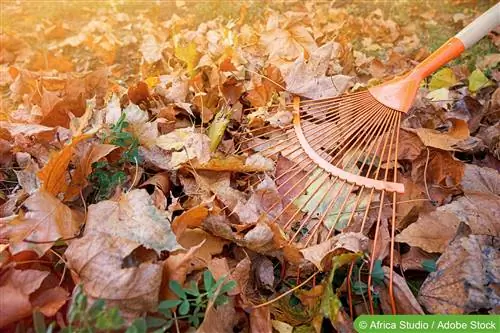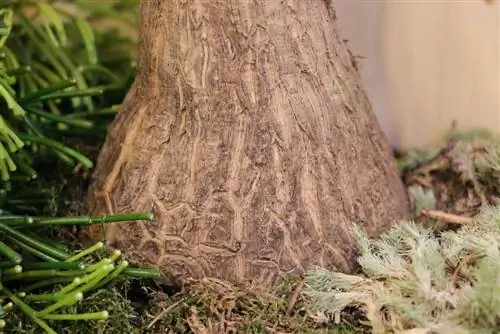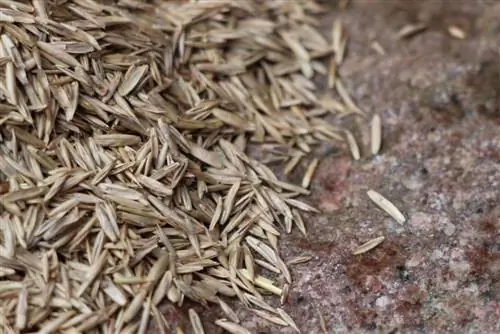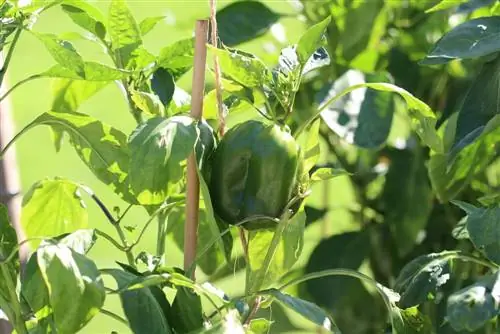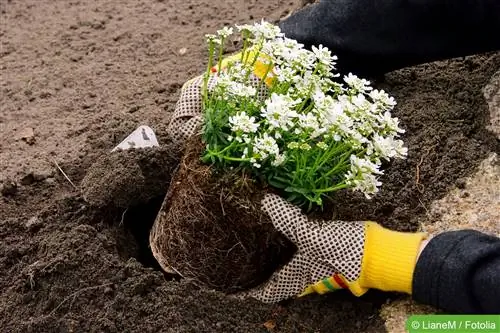- Author admin [email protected].
- Public 2023-12-17 03:39.
- Last modified 2025-06-01 06:48.
Summer is finally coming to an end. You notice this not only in the cold, frosty temperatures, but also in the fact that the flowers in the garden, on the balcony and on the terrace are diminishing. Now it's time to clean up and now it's time to make the garden, balcony and terrace winter-proof. The last lawn cut is also due. In November, the hobby gardener has his hands full.
Gardening in November
- Pot plants that are not hardy should be cut back and put away now at the latest. The cold nights could otherwise cause serious tissue damage that could no longer be repaired. Anything withered must be cut off. If the soil in the pots is still too wet, you should first place the plants protected from the rain for a few days (under a canopy, under the carport, etc.) so that the soil can dry out a little. Soil that is too wet in winter quarters can lead to serious root damage.
- The lawn needs to be cut short one last time. Leaves and other plant residues should be completely removed from the lawn to prevent mold from forming. The soil under the lawn should and must remain permeable even in winter. A final fertilization is also helpful. After the last lawn cut, the lawn mower and the brush cutter should be winterized immediately. All equipment should come into the winter clean. It's better to do minor repair work now so that you don't have to waste time next spring.
- You should also use scissors in the perennial bed now. Wilted perennials should be cut off. You can safely leave the flower remains of stonecrop. They are not only an ornament in the winter garden, they also protect the plants from cold and excessive moisture. Perennials where the seed heads have not been removed can also be left standing; they provide plenty of food for many birds.
- Plants planted in autumn should be given some protection in the first winter. To do this, you can pile up some soil in the root area of the plants or protect them from the cold with a thick layer of leaves. The same applies to roses. Cut off spent shoots cleanly and pile up the rose bushes. Here too you can add a thick layer of leaves.
- Fruit trees can still be planted now. Only a few types are an exception, such as peaches, apricots or walnuts. These are better planted in spring. Berry bushes that have grown too densely can now be thinned out. Do not prune, only remove disturbing or dead shoots. Freshly planted fruit trees are grateful for a generous dose of compost. This not only serves as a starting aid, but also as winter protection.
- In the vegetable garden you harvest the last vegetables. All vegetables whose underground parts are eaten (carrots, beets) should be harvested before the first frosts. Only leeks, Brussels sprouts and kale can remain in the beds. In any case, kale only tastes really good when it has been exposed to some frost.
- Last but not least, the garden tools that are no longer needed are thoroughly cleaned, greased and stored for the winter. This ensures that you can start work next spring with tip-top equipment.
More gardening tips for November
November is really cold. Frost is moving through the country. The final work needs to be done in the garden before winter. Most trees and bushes have already shed their leaves. It gets dark early and the time for gardening needs to be planned carefully. Because before the garden sinks into hibernation, there is still harvesting and tidying up.
November doesn't always make it easy for the gardener to set foot in his garden. The weather is often wet and cold and it gets dark early. But right now it's worth finally making the garden winter-proof. Now we're harvesting again, the last leaves are being gathered, beds and potted plants are being made winter-proof and the garden is being tidied up. There is still a lot to do before winter rest can take hold.
Fruit trees
Now is the right time for autumn pruning for the fruit trees. It is a guarantee for a good harvest in the coming year and for the he althy development of the fruit trees. The harvest period of the respective fruit tree must be completed before pruning. The best time to prune is midday or afternoon when temperatures are above 0°C. Then the wounds left by cutting on the branches and twigs will heal quickly and safely.
Where to put the autumn leaves
The autumn leaves of walnut, oak, chestnut or poplar and various other trees and shrubs rot badly. In order to be able to dispose of it usefully, it is advisable to shred these leaves. It is then mixed in a ratio of one part leaves to four parts organic materials such as grass clippings, small twigs and kitchen waste and can then be composted. Easily rotting leaves can be applied directly to the beds. It serves as good frost protection here and largely rots over the course of the winter.
Tip:
If you want to provide small animals with winter quarters, rake the leaves into corners of the garden that are protected from the wind. Such quarters are really important and are very well received.
The garden - frost-proof and winter-proof
- Perennials such as catnip, lady's mantle and mugwort are now cut off.
- The beds that have already been cleared and freed from weeds will now be protected from loss of nutrients and frost damage in November with compost, mulch, grass clippings and garden waste.
- In order to provide the air for the microorganisms in the soil to live, the cover should only be 1 to 2 cm high.
- If applied too thickly, the soil will be suffocated and rot will occur.
- Autumn leaves can remain on shaded beds and under bushes and trees.
- Also on shade perennials and shade-tolerant ground covers.
- However, the classic bedding perennials and the lawn require light. No leaves should be left here.
Tip:
Even if the garden is tidied up, perennials with seed pods should remain standing. They decorate the winter garden and provide food for birds.
Overwintering potted plants
In order for potted plants to survive the winter well, some precautions must be taken. The clay pots should not be placed on the ground. Especially in winter, the water must be able to drain well so that the pots do not shatter due to the frost. The roots of the potted plants should be surrounded with as much soil as possible. This protects them from frost. Deep and wide planters are best used for autumn planting. Fertilizer is avoided in winter. The nutrients in the potting soil are sufficient for the roots of potted plants. However, seedlings should be watered as long as it doesn't freeze.
The potted plants that are not hardy must be brought into the house where they can overwinter brightly and frost-free. The winter quarters do not necessarily have to be a winter garden. Unheated and bright basement rooms, stairwells or garages can function well as winter quarters. However, temperatures should not fall below 0 °C.
Tip:
The lower the room temperature, the darker the room can be for overwintering. Some species, such as myrtle or spice bark, even survive without light.
Roses and Dahlias
Roses are grateful for winter protection. Compost as well as well-seasoned horse or cattle manure are possible. The material should extend beyond the processing point. The fertilizer provides the roots with nutrients and at the same time protects the plant from frost. Climbing roses should also be securely attached to the trellis so that the branches cannot break under the weight of snow.
The tuber of the dahlia is not hardy. Therefore, they must be removed from the ground after the first ground frost at the latest. To overwinter, the leaves of the dahlias are cut off and the tubers are placed in a spacious box in a frost-free, cool and dark place. The tubers can be covered with a little leaves or sawdust. When they go into the ground at the beginning of May, they bloom again from late summer into autumn.
Tip:
Damaged or even rotten tubers must be sorted out before storage in order to keep the other tubers he althy.
Time for winter vegetables
Now it's time to harvest the tasty, vitamin-rich and wholesome Chinese cabbage. Although it can tolerate light frost, it should not freeze to death.
If you want to harvest chives in winter, you should put them in pots now. The chives are dug up before the frost period. The root ball remains on the ground to be driven. Once it is frozen, it is potted up and further cultivated on the windowsill or in the greenhouse at around eighteen degrees Celsius.
Slight frost doesn't harm Brussels sprouts either. It even ensures that the sugar content in the florets is increased, giving them their tasty aroma. However, the florets should not be picked when there is frost. It is better to wait until the Brussels sprouts are thawed.
Tip:
Always harvest Brussels sprouts from the bottom up. This allows the buds to grow back and produce a high harvest.
Last work in November
The lawnmower is no longer needed for this gardening season. Now he needs some care. The device must be cleaned thoroughly. If you have an electric mower, the battery should be disconnected. With a motor mower, the petrol tank is filled to the top and the petrol tap is closed. Now let the mower run until the engine stops due to lack of fuel. This way the carburettor empties and doesn't get gummed up during the winter break.
If you have a garden pond, you should now thoroughly clear it of any plant parts that have fallen into it. Their decomposition uses so much oxygen that fish, frogs and newts would die. Exotic pond plants, sensitive fish or water lilies should definitely be protected from frost over the winter. And if the garden hose and rain barrel are emptied and the outside taps are closed, winter can move into the garden.

